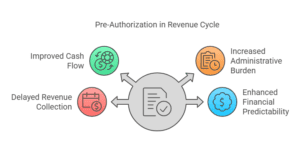In the healthcare industry, managing the revenue cycle efficiently is critical for maintaining a healthy cash flow and ensuring timely reimbursement for services rendered. One of the key processes that play a pivotal role in optimizing revenue cycle efficiency is pre-authorization. Pre-authorization is the process by which a healthcare provider obtains approval from an insurance company or payer before performing a specific service or procedure. It ensures that the insurer will cover the cost of the service, preventing denials and delays in reimbursement.
In this article, we will explore the importance of pre-authorization in improving revenue cycle efficiency, reducing claim denials, and ensuring timely payments for healthcare providers.
Why Pre-Authorization is Essential for Revenue Cycle Efficiency
Pre-authorization is crucial because it prevents the financial risk associated with services that might not be covered by insurance. By obtaining pre-authorization, healthcare providers ensure that the procedure or service will be reimbursed, eliminating the possibility of delayed or denied claims. In addition, it streamlines the overall revenue cycle process by ensuring that both the provider and payer are aligned on the scope of coverage, thus enabling smoother billing and payment processes.
Here’s why pre-authorization is essential:
- Ensures payer coverage: Pre-authorization helps confirm that the service or procedure will be covered by the patient’s insurance plan, reducing the risk of claim denials.
- Improves cash flow: By reducing claim denials and rework, pre-authorization helps healthcare providers ensure timely reimbursement, improving overall cash flow.
- Reduces administrative burden: With pre-authorization in place, healthcare providers can focus on providing care, rather than dealing with rejected claims and lengthy appeals.
How Pre-Authorization Impacts the Revenue Cycle

Pre-authorization influences several aspects of the revenue cycle, from service delivery to final reimbursement. Here’s how it impacts the overall process:
1. Reduces Claim Denials and Rejections
One of the most significant benefits of pre-authorization is its ability to reduce claim denials. When a service or procedure is pre-authorized, the healthcare provider has confirmation from the insurance company that the service will be covered. Key benefits include:
- Fewer denials: Without pre-authorization, claims are more likely to be rejected by insurance companies due to a lack of coverage verification.
- Faster reimbursements: By obtaining pre-authorization, healthcare providers can avoid rework and resubmissions, ensuring quicker reimbursements.
2. Improves Service Delivery and Patient Satisfaction
Pre-authorization helps eliminate any uncertainty surrounding insurance coverage, allowing healthcare providers to deliver services with greater confidence. How it impacts patient care:
- Clear communication with patients: By obtaining pre-authorization, healthcare providers can inform patients upfront about their financial responsibility, improving transparency and trust.
- Reduced patient billing issues: With pre-authorization, patients are more likely to have their services covered, reducing confusion and potential financial stress.
3. Smooth Billing and Coding Processes
When pre-authorization is obtained, the associated codes and billing information can be accurately documented, reducing the chances of errors during the billing process. How it impacts the billing process:
- Clear documentation: Pre-authorization provides a record of what was approved, ensuring that the billing team can accurately bill for the services rendered.
- Fewer coding errors: When services are pre-authorized, it helps prevent the wrong codes from being submitted, reducing the risk of coding errors that can lead to denials or delays.
4. Enhances Financial Planning and Cash Flow
Pre-authorization provides insight into the financial aspects of care, helping healthcare providers plan their revenue cycle more effectively. Financial benefits include:
- Predictable revenue: By ensuring that services are covered by insurance, pre-authorization allows providers to better predict their revenue and reduce the uncertainty of pending claims.
- Cash flow stability: Reducing claim denials and delays in reimbursement improves cash flow, making it easier for healthcare providers to cover operational costs and invest in patient care.
5. Mitigates Risk of Underpayments
Without pre-authorization, healthcare providers may face situations where the insurance payer reduces or rejects payment after a service has been rendered. Pre-authorization helps mitigate this risk. How it prevents underpayments:
- Clarifies coverage limits: Pre-authorization confirms the amount the payer will cover, ensuring that the healthcare provider knows what to expect in terms of payment.
- Avoids surprises: By securing pre-authorization, the provider and patient both understand the coverage limits and avoid the risk of underpayment or unexpected financial responsibility.
6. Facilitates Payer and Provider Alignment
Pre-authorization ensures that both the healthcare provider and the insurance payer are aligned on the services to be provided and the terms of coverage. Benefits of alignment:
- Preventing billing discrepancies: By confirming coverage with the payer beforehand, both parties avoid discrepancies related to reimbursement amounts or procedures.
- Smoother negotiations: Pre-authorization helps build a more collaborative relationship between the provider and the insurer, streamlining the claims process.
Best Practices for Efficient Pre-Authorization in the Revenue Cycle
To fully leverage the benefits of pre-authorization, healthcare providers should implement the following best practices:
1. Integrate Pre-Authorization into the Workflow
Pre-authorization should be an integrated part of the overall revenue cycle process. Ensure that the staff involved in scheduling, billing, and coding are all trained on the importance of pre-authorization and the steps involved.
2. Automate Pre-Authorization Requests
Automating pre-authorization requests through EHR (electronic health records) or RCM software can reduce the administrative burden and ensure that requests are submitted on time. Automation also ensures that the pre-authorization process is streamlined and accurate.
3. Set Clear Guidelines and Criteria for Pre-Authorization
Establish clear guidelines for which services require pre-authorization and set criteria for ensuring timely submission of requests. This helps avoid delays and reduces the chances of missing a necessary pre-authorization.
4. Track and Follow Up on Pre-Authorization Status
Ensure that pre-authorization requests are tracked and follow-ups are made on any outstanding authorizations. Automated reminders or dashboards can help keep the process on track.
5. Communicate Clearly with Patients
Clear communication with patients regarding the pre-authorization process is essential. Inform patients about their financial responsibility and any necessary steps they need to take before receiving care.
Conclusion
Pre-authorization plays a critical role in optimizing revenue cycle efficiency for healthcare providers. By ensuring insurance coverage before services are rendered, healthcare organizations can reduce claim denials, improve cash flow, streamline billing processes, and enhance patient satisfaction. Incorporating pre-authorization into the revenue cycle helps healthcare providers provide timely, high-quality care while ensuring financial stability.
What People Are Asking
1. Why is pre-authorization important in revenue cycle management?
Pre-authorization ensures that services will be covered by insurance, reducing the risk of claim denials, improving cash flow, and streamlining the billing process.
2. How does pre-authorization impact patient satisfaction?
Pre-authorization helps avoid billing surprises by ensuring that both patients and providers are aware of financial responsibility, leading to better transparency and trust.
3. How can I reduce claim denials through pre-authorization?
By obtaining pre-authorization, providers can confirm coverage before services are rendered, ensuring that claims are submitted with the correct documentation and codes, reducing the likelihood of denials.
4. What role does pre-authorization play in financial planning?
Pre-authorization provides insight into coverage and reimbursement, helping providers predict revenue and ensure financial stability.
5. How can I improve the pre-authorization process?
Automating pre-authorization requests, integrating it into the workflow, and setting clear guidelines for which services require authorization can streamline the process and improve efficiency.
Disclaimer
For informational purposes only; not applicable to specific situations.
For tailored support and professional services,
please contact Staffingly, Inc. at (800) 489-5877
Email: support@staffingly.com.
About This Blog: This Blog is brought to you by Staffingly, Inc., a trusted name in healthcare outsourcing. The team of skilled healthcare specialists and content creators is dedicated to improving the quality and efficiency of healthcare services. The team passionate about sharing knowledge through insightful articles, blogs, and other educational resources.
 Book a Demo to Build Your Team Today!
Book a Demo to Build Your Team Today!

 Read Case Studies
Read Case Studies 



 Virtual Medical Assistants
Virtual Medical Assistants



